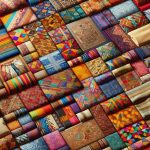Are you curious about the beautiful and versatile sari silk fabric? Well, you’re in luck!
In this article, we’ll explore the history, production process, characteristics, and uses of sari silk fabric. You’ll discover why it’s a popular choice for various applications and how it stands out with its unique qualities.
We’ll also delve into the sustainability and ethical aspects surrounding this exquisite fabric.
So, sit back and get ready to unravel the wonders of sari silk fabric.
Table of Contents
History of Sari Silk Fabric
The history of sari silk fabric dates back centuries. This luxurious and vibrant fabric has a deep cultural significance in Indian traditions and is known for its exquisite beauty and craftsmanship. The art of creating sari silk fabric involves traditional techniques that have been passed down through generations.
Sari silk fabric holds a special place in Indian culture. It is often associated with weddings, festivals, and other important occasions. The vibrant colors and intricate designs of sari silk reflect the rich cultural heritage of India. The fabric is not just a piece of clothing, but a symbol of femininity, grace, and elegance.
The production of sari silk fabric involves traditional techniques that have been perfected over time. The process begins with the extraction of silk fibers from the cocoons of silkworms. These fibers are then spun into yarn and dyed using natural dyes made from plants and minerals. Skilled artisans then weave the yarn into intricate patterns and designs using traditional handlooms. The result is a fabric that is not only visually stunning but also has a soft and luxurious feel.
The history of sari silk fabric is a testament to the rich cultural heritage and traditional techniques of India. Its cultural significance and timeless beauty continue to make it a cherished part of Indian fashion and traditions.
Production Process of Sari Silk Fabric
During the production process of sari silk fabric, artisans carefully spin the recycled fibers into a strong and versatile material. Here’s a step-by-step breakdown of how sari silk fabric is made:
-
Collecting and sorting the silk: The process begins with the collection of old and discarded silk saris. These saris are then sorted based on their colors, patterns, and quality.
-
Degumming the silk: The collected saris are boiled in a solution of water and soap to remove the natural gum called sericin. This degumming process helps to soften the silk fibers and make them easier to work with.
-
Carding and blending: After degumming, the silk fibers are carded to remove any impurities and align them in a parallel manner. The fibers are then blended together to create a consistent and even mixture.
-
Spinning the silk: The carded and blended silk fibers are spun into yarn using spinning wheels or machines. This spinning process creates strong and fine threads of sari silk.
-
Weaving the fabric: Finally, the sari silk yarn is woven into beautiful fabric on traditional handlooms. Skilled artisans meticulously create intricate patterns and designs, using their expertise to bring out the unique beauty of the sari silk fabric.
Characteristics and Qualities of Sari Silk Fabric
When creating sari silk fabric, you’ll notice its unique characteristics and qualities. Sari silk fabric is known for its durability and strength, making it a long-lasting and reliable material. It can withstand regular wear and tear, making it suitable for various applications. Its versatility allows it to be used in a wide range of products, from clothing to home decor items.
One of the standout features of sari silk fabric is its unique texture. It has a soft and smooth feel, making it comfortable to wear against the skin. The texture adds a luxurious touch to any garment or accessory made from it. Additionally, the vibrant colors and intricate patterns found in sari silk fabric make it visually appealing and eye-catching.
To further illustrate the qualities of sari silk fabric, here is a table highlighting its durability, strength, versatility, and unique texture:
| Qualities | Characteristics |
|---|---|
| Durability | Withstands regular wear and tear |
| Strength | Long-lasting and reliable |
| Versatility | Suitable for various applications |
| Unique Texture | Soft, smooth, and luxurious feel |
| Vibrant colors | Eye-catching and visually appealing |
Uses and Applications of Sari Silk Fabric
Sari silk fabric can be utilized in various ways due to its versatility and unique qualities. Whether you’re in the fashion industry or simply looking for creative DIY projects, sari silk fabric offers endless possibilities.
Here are a few ideas to inspire you:
-
In the fashion industry:
-
Designers can use sari silk fabric to create stunning garments, adding vibrant colors and intricate patterns to their collections.
-
Sari silk scarves and shawls are popular accessories that can elevate any outfit, adding a touch of elegance and luxury.
-
For creative DIY projects:
-
Sari silk fabric can be repurposed into beautiful home decor items such as pillow covers, curtains, or table runners, instantly adding a bohemian and exotic vibe to your space.
-
Upcycling old sari silk fabric into unique bags, clutches, or pouches is a great way to give new life to discarded materials and express your creativity.
The fashion industry has been greatly impacted by the use of sari silk fabric, as it offers a sustainable and eco-friendly alternative to synthetic materials. Its vibrant colors and rich textures bring a touch of cultural diversity to the fashion world.
Additionally, by incorporating sari silk fabric into your DIY projects, you not only contribute to sustainability but also create one-of-a-kind pieces that reflect your personal style. So, let your imagination run wild and explore the endless possibilities of sari silk fabric!
Sustainability and Ethical Aspects of Sari Silk Fabric
The sustainability and ethical aspects of using sari silk fabric are important considerations for conscious consumers. Sari silk fabric is not only beautiful and vibrant, but it also has great upcycling potential. By repurposing old saris into new garments or accessories, you can reduce waste and give new life to these traditional textiles. Additionally, many sari silk fabrics are made by artisans who are part of fair trade organizations. This means that the production of sari silk fabric supports fair wages, safe working conditions, and the empowerment of women in developing countries.
To further illustrate the sustainability and ethical aspects of sari silk fabric, let’s take a look at the following table:
| Sustainability Aspect | Ethical Aspect |
|---|---|
| Upcycling potential | Fair trade certification |
| Reduces waste by repurposing old saris | Supports fair wages and safe working conditions |
| Gives new life to traditional textiles | Empowers women in developing countries |
As you can see, sari silk fabric offers both environmental and social benefits. By choosing products made from sari silk fabric, you can contribute to a more sustainable and ethical fashion industry.
Conclusion
In conclusion, sari silk fabric is a fascinating textile with a rich history and unique production process. Its characteristics and qualities, such as its softness and vibrant colors, make it a popular choice for various applications.
Additionally, sari silk fabric is an environmentally sustainable and ethical option, as it is made from recycled materials and supports fair trade practices.
So, whether you’re looking for a beautiful fabric for clothing or home decor, sari silk fabric is a great choice that combines beauty and sustainability.
- Ikat Fabric: A Trend That Never Goes Out of Style - June 28, 2025
- A Guide to Buying Ikat Fabric Remnants for Small Projects - June 28, 2025
- The Unique Beauty of Abstract Ikat Designs - June 28, 2025



